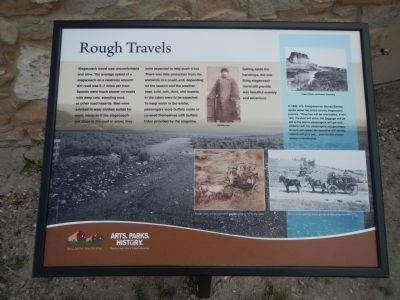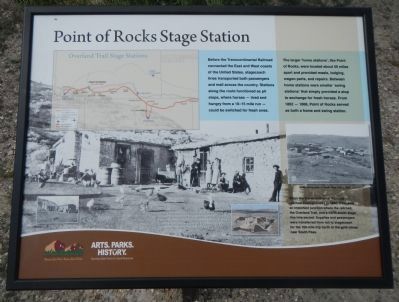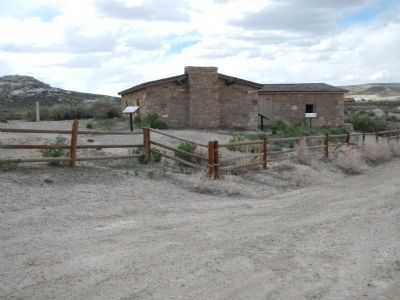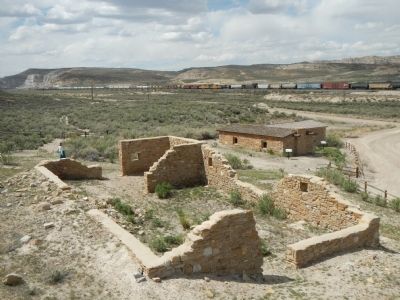Near Point of Rocks in Sweetwater County, Wyoming — The American West (Mountains)
Point of Rocks Stage Station
Inscription.
Before the Transcontinental Railroad connected the East and West coasts of the United States, stage coach lines transported both passengers and mail across the country. Stations along the route functioned as pit stops, where horses - tired and hungry from a 10-15 mile run - could be switched for fresh ones.
The larger ‘home stations’, like Point of Rocks, were located about 50 miles apart and provided meals, lodging, wagon parts, and repairs. Between home stations were smaller ‘swing stations’ that simply provided a stop to exchange for fresh horses. From 1862 - 1868, Point of Rocks served as both a home and swing station.
When the Transcontinental Railroad reached Point of Rocks in 1868, it became an important junction where the railroad, the Overland Trail, and a north-south stage line intersected. Supplies and passengers were transferred from rail to stagecoach for the 100-mile trip north to the gold mines near South Pass.
Over time, the sod-roofed station at Point of Rocks also served as a store, schoolhouse, ranch headquarters and home before it was transferred to the State of Wyoming in 1947. The station was restored in 1974.
Erected by Wyoming State Parks & Cultural Resources.
Topics and series. This historical marker is listed in this topic list: Roads & Vehicles . In addition, it is included in the Overland Trail, and the Transcontinental Railroad series lists. A significant historical year for this entry is 1862.
Location. 41° 40.593′ N, 108° 47.46′ W. Marker is near Point of Rocks, Wyoming, in Sweetwater County. Marker is at the intersection of Black Butte Road and Oregon Trail on Black Butte Road. Touch for map. Marker is in this post office area: Point of Rocks WY 82942, United States of America. Touch for directions.
Other nearby markers. At least 8 other markers are within 11 miles of this marker, measured as the crow flies. An Unsolved Mystery (approx. 0.2 miles away); Point of Rocks (approx. 0.2 miles away); Overland Stage Route (approx. 0.4 miles away); Almond Overland Stage Station (approx. half a mile away); Immigrants (approx. 10.9 miles away); Working in the Mines (approx. 10.9 miles away); Town Development (approx. 10.9 miles away); Opening the Mines (approx. 10.9 miles away). Touch for a list and map of all markers in Point of Rocks.
Regarding Point of Rocks Stage Station. The Point of Rocks Stage Station is on the National Register of Historic Places as Wyoming Place No. 35.

Photographed By Barry Swackhamer, May 22, 2014
5. Rough Travels Plaque
Stagecoach travel was uncomfortable and slow. The average speed of a stage coach on a relatively smooth dirt road was 5-7 miles per hour. Speeds were much slower on roads with deep ruts, standing mud, and other road hazards. Men were advised to were clothes suited for work, because if the stagecoach got stuck in the mud or snow, they were expected to help push it out. There was little protection from the elements in the coach and, depending on the season and the weather, heat, cold, dust and insects in the cabin were to be expected. To keep warm in the winter, passengers wore buffalo coats or covered themselves with buffalo hides provided by the stage line.
In 1866, U.S. Congressman Demas Barnes spoke about his cross-country stagecoach journey: ”Coaches will be overloaded, it will rain, the dust will drive, the baggage will be left to the storm, passengers will get sick … children will cry, passengers will get angry, drivers will swear, the sensitive will shrink, rations will give out … and the dirt almost always unendurable.”
Captions, clockwise from the top-left; Buffalo coat; Green River, southwest Wyoming; Some routes required armed guards to discourage bandits; Rough roads and overcrowded coaches took its toll on travelers.
In 1866, U.S. Congressman Demas Barnes spoke about his cross-country stagecoach journey: ”Coaches will be overloaded, it will rain, the dust will drive, the baggage will be left to the storm, passengers will get sick … children will cry, passengers will get angry, drivers will swear, the sensitive will shrink, rations will give out … and the dirt almost always unendurable.”
Captions, clockwise from the top-left; Buffalo coat; Green River, southwest Wyoming; Some routes required armed guards to discourage bandits; Rough roads and overcrowded coaches took its toll on travelers.

Photographed By Barry Swackhamer, May 22, 2014
6. Stagecoach Rules Plaque
Traveling by stage across the West took several weeks and was dusty and uncomfortable. In order to make travel slightly more civilized, Wells Fargo posted rules for stagecoach etiquette.
Stagecoach Etiquette
Abstinence from liquor is requested, but if you must drink, share the bottle. To do otherwise makes you appear selfish and unneighborly.
Buffalo robes are provided for your comfort in colder weather. Hogging robes will not be tolerated an the offender will be made to ride with the driver.
Don’t snore loudly while sleeping or use your fellow passenger’s shoulder for a pillow, he or she may not understand and friction may result.
In the event of a runaway horse, remain calm. Leaping from the coach in panic will leave you injured, at the mercy of the elements, hostile Indians and hungry coyotes.
Gents guilty of unchivalrous behavior toward lady passenger will be put off the stage. It’s a long walk back; a word to the wise is sufficient.
Not everyone could manage a stagecoach. Drivers has to control four to six horses galloping at perilous speeds over treacherous frontier roads, where any miscue could hurl a coach hundreds of feet down a steep canyon. Some drivers were swaggering rough-spoke men, but in spite of these manners, nearly all of them were courteous, personable, and willing to recall their many exciting experiences.
Historian George Bancroft wrote: ”The average stage driver was above all, lord in his way, the captain of his raft, the fear of timid passengers, the admiration of stable boys, and the trusted agent of his employer.”
Captions: Stagecoach driver William Taylor (left); Stagecoach driver J.W. Miller (right).
Abstinence from liquor is requested, but if you must drink, share the bottle. To do otherwise makes you appear selfish and unneighborly.
Buffalo robes are provided for your comfort in colder weather. Hogging robes will not be tolerated an the offender will be made to ride with the driver.
Don’t snore loudly while sleeping or use your fellow passenger’s shoulder for a pillow, he or she may not understand and friction may result.
In the event of a runaway horse, remain calm. Leaping from the coach in panic will leave you injured, at the mercy of the elements, hostile Indians and hungry coyotes.
Gents guilty of unchivalrous behavior toward lady passenger will be put off the stage. It’s a long walk back; a word to the wise is sufficient.
Not everyone could manage a stagecoach. Drivers has to control four to six horses galloping at perilous speeds over treacherous frontier roads, where any miscue could hurl a coach hundreds of feet down a steep canyon. Some drivers were swaggering rough-spoke men, but in spite of these manners, nearly all of them were courteous, personable, and willing to recall their many exciting experiences.
Historian George Bancroft wrote: ”The average stage driver was above all, lord in his way, the captain of his raft, the fear of timid passengers, the admiration of stable boys, and the trusted agent of his employer.”
Captions: Stagecoach driver William Taylor (left); Stagecoach driver J.W. Miller (right).
Credits. This page was last revised on September 4, 2020. It was originally submitted on September 1, 2014, by Barry Swackhamer of Brentwood, California. This page has been viewed 685 times since then and 42 times this year. Photos: 1, 2, 3, 4, 5, 6. submitted on September 1, 2014, by Barry Swackhamer of Brentwood, California. • Bill Pfingsten was the editor who published this page.



